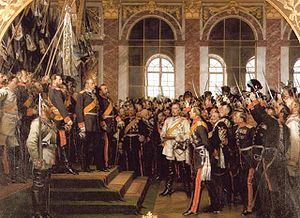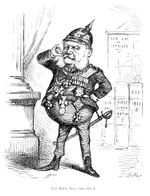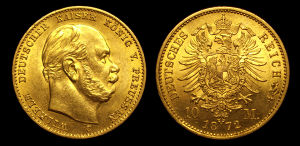William I, German Emperor
| William I | |
|---|---|
|
|
|
| Reign | 2 January 1861 – 9 March 1888 |
| Predecessor | Frederick William IV |
| Successor | Frederick III |
|
|
|
| Reign | 18 January 1871 – 9 March 1888 |
| Successor | Frederick III |
| Spouse | Augusta of Saxe-Weimar |
| Issue | |
| Frederick III, German Emperor Louise, Grand Duchess of Baden |
|
| House | House of Hohenzollern |
| Father | Frederick William III of Prussia |
| Mother | Louise of Mecklenburg-Strelitz |
| Born | 22 March 1797 Berlin, Prussia |
| Died | 9 March 1888 (aged 90) Berlin |
| Burial | Charlottenburg Palace, Berlin |
| Signature |  |
- REDIRECT
William I[1], also known as Wilhelm I[2] (full name: William Frederick Louis, German: Wilhelm Friedrich Ludwig) (22 March 1797 – 9 March 1888), of the House of Hohenzollern was the King of Prussia (2 January 1861 – 9 March 1888) and the first German Emperor (18 January 1871 – 9 March 1888).
Under the leadership of William and his Chancellor Otto von Bismarck, Prussia achieved the unification of Germany and the establishment of the German Empire.
Contents |
Early life and military career
The future king and emperor was born William Frederick Louis of Prussia (Wilhelm Friedrich Ludwig von Preußen) in Berlin. As the second son of King Frederick William III and Louise of Mecklenburg-Strelitz, William was not expected to ascend to the throne and hence received little education.
William served in the army from 1814 onward, fought against Napoleon I of France during the Napoleonic Wars, and was reportedly a very brave soldier. He fought under Gebhard Leberecht von Blücher at the Battles of Waterloo and Ligny. He also became an excellent diplomat by engaging in diplomatic missions after 1815.
During the Revolutions of 1848, William successfully crushed a revolt that was aimed at his elder brother King Frederick William IV. The use of cannons made him unpopular at the time and earned him the nickname Kartätschenprinz (Prince of Grapeshot).
In 1854, the prince was raised to the rank of a field-marshal and made governor of the federal fortress of Mainz.[3] In 1857 Frederick William IV suffered a stroke and became mentally disabled for the rest of his life. In January 1858, William became Prince Regent for his brother.
King
On 2 January 1861 Frederick William died and William ascended the throne as William I of Prussia. He inherited a conflict between Frederick William and the liberal parliament. He was considered a politically neutral person as he intervened less in politics than his brother. Wilhelm nevertheless found a conservative solution for the conflict: he appointed Otto von Bismarck to the office of Prime Minister. According to the Prussian constitution, the Prime Minister was responsible solely to the king, not to parliament. Bismarck liked to see his working relationship with William as that of a vassal to his feudal superior. Nonetheless, it was Bismarck who effectively directed the politics, domestic as well as foreign; on several occasions he gained Wilhelm's assent by threatening to resign.
Emperor

During the Franco-Prussian War, on 18 January 1871 in Versailles Palace, William was proclaimed German Emperor. The title "German Emperor" was carefully chosen by Bismarck after discussion until (and after) the day of the proclamation. William accepted this title grudgingly as he would have preferred "Emperor of Germany" which, however, was unacceptable to the federated monarchs, and would also have signalled a claim to lands outside of his reign (Austria, Switzerland, Luxembourg etc.). The title "Emperor of the Germans", as proposed in 1848, was ruled out as he considered himself chosen "by the grace of God", not by the people as in a democratic republic.

By this ceremony, the North German Confederation (1867–1871) was transformed into the German Empire ("Kaiserreich", 1871–1918). This Empire was a federal state; the emperor was head of state and president (primus inter pares – first among equals) of the federated monarchs (the kings of Bavaria, Württemberg, Saxony, the grand dukes of Baden, Mecklenburg, Hesse, as well as other principalities, duchies and the senates of the free cities of Hamburg, Lübeck and Bremen).
In his memoirs, Bismarck describes William as an old-fashioned, courteous, infallibly polite gentleman and a genuine Prussian officer, whose good common sense was occasionally undermined by "female influences".
Assassination attempts
On 11 May 1878, a plumber named Emil Max Hödel failed in an assassination attempt on Wilhelm in Berlin. Hödel used a revolver to shoot at the German Emperor, while the 82-year-old and his daughter, Princess Louise of Prussia, paraded in their carriage. When the bullet missed, Hödel ran across the street and fired another round which also missed. In the commotion one of the individuals who tried to apprehend Hödel suffered severe internal injuries and died two days later.
The State convicted Hödel after a photographer who took the radical’s picture days before the assassination attempt testified that after he took the picture Hödel said it would sell thousands once a certain piece of information [was] hashed through the world. Hödel was beheaded on 16 August 1878.
A second attempt was made on 2 June 1878, by the anarchist Karl Nobiling. Nobiling fired at the monarch from the window of a house in "Unter den Linden" as he drove past in an open carriage. The shot gravely wounded the 82 year old, who bled profusely as he was rushed back to the palace.
Anti-Socialist laws
Despite the fact that Hödel had been expelled from the Social Democratic Party, his actions were used as a pretext to ban the party through the Anti-Socialist Law in October 1878. To do this, Bismarck partnered with Ludwig Bamberger, a Liberal, who had written on the subject of Socialism, “If I don’t want any chickens, then I must smash the eggs.” No one in the Social-Democratic Party even knew of Karl Nobiling, but that is not to say that he was not politically motivated. Unfortunately, the aspiring assassin mortally wounded himself before he could be interrogated. The gunshot to the head did not immediately kill him, but he finally succumbed to his injuries in September 1878.
These attempts became the pretext for the institution of the Anti-Socialist Law, which was introduced by Bismarck’s government with the support of a majority in the Reichstag on 18 October 1878, for the purpose of fighting the socialist and working-class movement. The laws deprived the Social Democratic Party of Germany of its legal status; they prohibited all organizations, workers’ mass organizations and the socialist and workers’ press, decreed confiscation of socialist literature, and subjected Social-Democrats to reprisals.
The laws were extended every 2–3 years. Despite this policy of reprisals the Social Democratic Party increased its influence among the masses. Under pressure of the mass working-class movement the laws were repealed on 1 October 1890.
Issue
In 1829, William married Augusta of Saxe-Weimar and had two children:
- Frederick III, German Emperor (1831–1888) and
- Princess Louise of Prussia (1838–1923)
Titles, styles, honours and arms
| Monarchical styles of German Emperor William I, King of Prussia |
|
|---|---|
 |
|
| Reference style | His Imperial and Royal Majesty |
| Spoken style | Your Imperial and Royal Majesty |
| Alternative style | Sire |

Titles and styles
- 22 March 1797–2 January 1861: His Royal Highness Prince William of Prussia
- 2 January 1861–18 January 1871: His Majesty The King of Prussia
- 18 January 1871–9 March 1888: His Imperial and Royal Majesty The German Emperor, King of Prussia
Full title as German Emperor
His Imperial and Royal Majesty William the First, by the Grace of God, German Emperor and King of Prussia; Margrave of Brandenburg, Burgrave of Nuremberg, Count of Hohenzollern; sovereign and supreme Duke of Silesia and of the County of Glatz; Grand Duke of the Lower Rhine and of Posen; Duke of Saxony, of Westphalia, of Angria, of Pomerania, Lunenburg, Holstein and Schleswig, of Magdeburg, of Bremen, of Guelders, Cleves, Jülich and Berg, Duke of the Wends and the Kassubes, of Crossen, Lauenburg and Mecklenburg; Landgrave of Hesse and Thuringia; Margrave of Upper and Lower Lusatia; Prince of Orange; Prince of Rügen, of East Friesland, of Paderborn and Pyrmont, of Halberstadt, Münster, Minden, Osnabrück, Hildesheim, of Verden, Cammin, Fulda, Nassau and Moers; Princely Count of Henneberg; Count of Mark, of Ravensberg, of Hohenstein, Tecklenburg and Lingen, of Mansfeld, Sigmaringen and Veringen; Lord of Frankfurt.[4][5]
Memorials
From 1867 to 1918 more than 1,000 memorials to William I were constructed, including the Kyffhäuser Monument in Thuringia.
See also
- German monarchs family tree. He was related to every other monarch of Germany.
Ancestry
| Ancestors of William I, German Emperor | ||||||||||||||||||||||||||||||||||||||||||||||||||||||||||||||||||||||||||||||||||||||||||||||||||||||||||||||||||||||||||||||||||||||||||||||||||||||||||||||||||||||||||||||||||||||||||||||||||||||||||||||||||||||||||||||||||||||||||||||||||||||||||||||||||||||||||||||||||||||||||||||||||||||||||||||||||||||||||||||||||||||||||||||||||||||||||||||||||||||||||||||||||||||||||||||||||||||||||||||||||||||||||||||||||||||||||||||||||||||||||||||||||||||||||||||||||||||||||||||||||||||||||||||||||||||||||||||||||||||||||||||||||||||||||||||||||
|---|---|---|---|---|---|---|---|---|---|---|---|---|---|---|---|---|---|---|---|---|---|---|---|---|---|---|---|---|---|---|---|---|---|---|---|---|---|---|---|---|---|---|---|---|---|---|---|---|---|---|---|---|---|---|---|---|---|---|---|---|---|---|---|---|---|---|---|---|---|---|---|---|---|---|---|---|---|---|---|---|---|---|---|---|---|---|---|---|---|---|---|---|---|---|---|---|---|---|---|---|---|---|---|---|---|---|---|---|---|---|---|---|---|---|---|---|---|---|---|---|---|---|---|---|---|---|---|---|---|---|---|---|---|---|---|---|---|---|---|---|---|---|---|---|---|---|---|---|---|---|---|---|---|---|---|---|---|---|---|---|---|---|---|---|---|---|---|---|---|---|---|---|---|---|---|---|---|---|---|---|---|---|---|---|---|---|---|---|---|---|---|---|---|---|---|---|---|---|---|---|---|---|---|---|---|---|---|---|---|---|---|---|---|---|---|---|---|---|---|---|---|---|---|---|---|---|---|---|---|---|---|---|---|---|---|---|---|---|---|---|---|---|---|---|---|---|---|---|---|---|---|---|---|---|---|---|---|---|---|---|---|---|---|---|---|---|---|---|---|---|---|---|---|---|---|---|---|---|---|---|---|---|---|---|---|---|---|---|---|---|---|---|---|---|---|---|---|---|---|---|---|---|---|---|---|---|---|---|---|---|---|---|---|---|---|---|---|---|---|---|---|---|---|---|---|---|---|---|---|---|---|---|---|---|---|---|---|---|---|---|---|---|---|---|---|---|---|---|---|---|---|---|---|---|---|---|---|---|---|---|---|---|---|---|---|---|---|---|---|---|---|---|---|---|---|---|---|---|---|---|---|---|---|---|---|---|---|---|---|---|---|---|---|---|---|---|---|---|---|---|---|---|---|---|---|---|---|---|---|---|---|---|---|---|---|---|---|---|---|---|---|---|---|---|---|---|---|---|---|---|---|---|---|---|---|---|---|---|---|---|---|---|---|---|---|---|---|---|---|---|---|---|---|---|---|---|---|---|---|---|---|---|---|---|---|---|---|---|---|---|---|---|---|---|---|---|---|---|---|---|---|---|---|---|---|---|---|---|---|---|---|---|---|---|---|---|---|---|---|---|---|---|---|---|---|---|---|---|---|---|---|---|---|---|---|---|---|---|---|---|---|---|---|---|---|---|---|---|---|---|---|---|---|---|---|---|---|---|---|---|---|---|---|---|---|---|
|
||||||||||||||||||||||||||||||||||||||||||||||||||||||||||||||||||||||||||||||||||||||||||||||||||||||||||||||||||||||||||||||||||||||||||||||||||||||||||||||||||||||||||||||||||||||||||||||||||||||||||||||||||||||||||||||||||||||||||||||||||||||||||||||||||||||||||||||||||||||||||||||||||||||||||||||||||||||||||||||||||||||||||||||||||||||||||||||||||||||||||||||||||||||||||||||||||||||||||||||||||||||||||||||||||||||||||||||||||||||||||||||||||||||||||||||||||||||||||||||||||||||||||||||||||||||||||||||||||||||||||||||||||||||||||||||||||
References
- ↑ Fulbrook, Mary (2004). A Concise History of Germany, 2nd edition, 2004, Cambridge University Press, p. 128. ISBN 978-0-521-54071-1.
- ↑ Ybarra, Thomas R. Wilhelm II. (1921). The Kaiser's Memoirs: Wilhelm II, Emperor Of Germany, 1888–1918. Harper And Brothers Publisher. ISBN 0548323305
- ↑ 1911 Encyclopædia Britannica/William I (Germany)
- ↑ http://web.archive.org/web/20071222124050/http://regiments.org/biography/royals/1859wilG.htm
- ↑ Rudolf Graf v. Stillfried: Die Titel und Wappen des preußischen Königshauses. Berlin 1875.
Further reading
- Thomas Weiberg: … wie immer Deine Dona. Verlobung und Hochzeit des letzten deutschen Kaiserpaares. Isensee-Verlag, Oldenburg 2007, ISBN 978-3-89995-406-7
External links
- Archontology.org – Wilhelm I
- Willkommen bei preussen.de (German)
- Works by or about William I, German Emperor in libraries (WorldCat catalog)
 Texts on Wikisource:
Texts on Wikisource:
- “William I (Germany),” Encyclopædia Britannica, 11th ed., 1911
- Carl Schurz, Kaiser Wilhelm I, 1888
|
William I, German Emperor
Born: 22 March 1797 Died: 9 March 1888 |
||
| German nobility | ||
|---|---|---|
| Preceded by Frederick William IV |
King of Prussia 2 January 1861 – 9 March 1888 Prince Regent since 1858 |
Succeeded by Frederick III |
| New creation |
German Emperor 18 January 1871 – 9 March 1888 |
|
| Preceded by Christian IX of Denmark |
Duke of Saxe-Lauenburg 1864–1876 |
Incorporated into the Prussian crown |
| Vacant
Treaty of Vienna
Title last held by
Frederick VII of Denmark |
Duke of Schleswig and Holstein 1864–1888 |
|
| Preceded by Adolphe of Luxembourg as Duke of Nassau |
Prince of Nassau 1866–1888 |
|
| Preceded by Frederick William of Hesse as Elector of Hesse |
Landgrave of Hesse Prince of Fulda 1866–1888 |
|
| Preceded by Karl Fellner as Elder Mayor of Frankfurt |
Lord of Frankfurt 1866–1888 |
|
| Preceded by George V of Hanover as King of Hanover |
Prince of East Friesland, Osnabrück, Hildesheim and Verden Count of Lingen and Tecklenburg 1866–1888 |
|
| Political offices | ||
| Preceded by Francis Joseph I of Austria as President of the German Confederation |
President of the North German Confederation 1 July 1867 – 18 January 1871 |
Confederation abolished |
|
||||||||||||||||||||||||||||||||||||||
|
|||||||||||||||||
|
|||||||||||||||||||||||||||||||
|
||||||||||||||
|
||||||||||||||||||||
|
||||||||||||||
